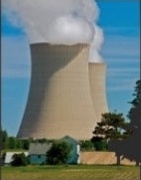By Serhii Plokhy
[…]
In the meantime, we obviously have an existing nuclear industry, and the solution is not to run away in panic, but to take good care of the facilities that already dot our countryside. We must not abandon the industry to its current state of economic hardship, as that would only mean inviting the next accident sooner rather than later. We should improve the safety of existing nuclear reactors by creating new standards to protect them not only from the natural disasters but also from man-made ones such as war.
The Windscale piles were shut down in the autumn of 1957. That was not the end, but rather the beginning of a process that took decades to complete. Shutting down a nuclear facility is no easy task: since Wigner energy remained in the graphite of the piles, they needed constant monitoring. For decades, technology and equipment required for the proper decontamination of the site were lacking, and it was not until 1999 that work began on removing the highly contaminated parts of the reactor, along with the remaining 15 tonnes of fuel, from the damaged area of Pile No 1. The Windscale piles entered the new millennium without fuel but with their deteriorating stacks still reaching dangerously into the sky. While the chimney of Pile No 2 was partly dismantled in 2001, work on demolishing No 1 only began three years ago.
Those stark concrete piles lasted from the beginning of the cold war to the brink of a new one. But as uncanny as the other parallels may seem, this time we do not need to plunge headlong into a nuclear future.
On 10 October 1957, Harold Macmillan sent a letter to President Dwight Eisenhower. The question he asked his US counterpart was: “What are we going to do about these Russians?” The launch of the Sputnik satellite six days earlier had carried with it the threat that Soviet military technology would eclipse that of the west. The prime minister was hoping to boost British nuclear capabilities, and was desperate for US cooperation.
On that same day, however, the UK’s most advanced nuclear project went up in flames – putting the knowledge and bravery of its best scientists to the test, and threatening England’s peaceful countryside with a radiological disaster.
Britain’s first atomic establishment had been hurriedly put together after the second world war. It had turned the small village of Seascale, on the Cumbrian coast, into one of Britain’s most highly educated places, brimming with nuclear scientists and engineers. At the centre of this rarified new world were two buildings: Windscale piles No 1 and No 2. They were Britain’s first nuclear reactors, on a campus that for decades afterwards would be used to produce energy for the grid, but their primary purpose was to produce the material for a British bomb.
One atomic energy official would later refer to the piles as “monuments to our initial ignorance”, and it was ignorance about one particular nuclear phenomenon that almost led to disaster. “Wigner energy” is the energy that accumulates in the graphite blocks that make up the main body of the reactor while the fission reaction is taking place. If it’s not released in time, the energy can build up to such an extent that it ignites the graphite. Periodically, a special operation called “annealing” has to be undertaken in order to release the excess energy.
Macmillan wanted Windscale to produce more plutonium and tritium for a hydrogen bomb as quickly as possible. But annealing required stopping the reactor. The Windscale Technical Evaluation Committee decided it would be safe to do it less often. Managers had scheduled the annealing of Pile No 1 for early October 1957, but it was long overdue.
It began at 11.45am on 7 October, under the supervision of physicist Ian Robertson. Everything seemed to go according to plan, and after a long day Robertson went home to get some sleep. He felt unwell. The whole village was feeling the impact of a global flu pandemic – a virus that combined strains of avian and human influenza that had emerged from Guizhou, China, the previous year. Many of Robertson’s colleagues and their families had fallen ill. But no attempts were made to quarantine, and people had continued to show up for work. After spending a few hours at home, Robertson was back at the pile for 9am the following day. It must have seemed as if the flu had not only infected Robertson but the reactor as well. The temperature in the pile was not behaving as predicted and it was a challenge to keep things stable. The oOperators managed to maintain control for the rest of the day and night, but on 9 October the temperature began to rise again. As the situation became critical, no one could tell what was going on inside the pile.
“Someone suggested that we actually have a look at the reactor itself,” Arthur Wilson, then a 32-year-old instrument technician, later recalled. “We thought: ‘What the hell.’ I opened the gag-port and there it was – a fire at the face of the reactor.” Normally it was dark, but now the channels were glowing bright red from the soaring temperature. “I can’t say I thought a lot about it at the time, there was so much to do,” continued Wilson. “I didn’t think ‘Hurrah, I’ve found it.’ I rather thought, ‘Oh dear, now we are in a pickle.’”
[…]
What the Russian takeover of these nuclear facilities exposed is a hazard inherent in all nuclear power. In order for this method of producing electricity to be safe, everything else in society has to be functioning perfectly. Warfare, economic collapse, climate change itself – all of these increasingly real risks make nuclear sites potentially perilous places. Even without them, the dangers of atomic fission remain, and we must ask ourselves: are they really worth the cost?
[…]
If what we bury today in the New Mexico desert – the waste created by our nuclear ambitions – is so repulsive to us, why do we pass it on to others to deal with?
This leaves us with the obvious question: if nuclear power is not a safe option for the future, what should we do about the growing need for energy and the demands imposed on us by the climate crisis? It’s true that renewables cannot fill the gap left by Russian supply overnight, but surely new investments should go not into the improvement of outdated 20th-century technologies, but instead into the energy technologies of the 21st century. Although coal and oil between them still account for 60% of global electricity generation, renewable sources – which include hydroelectric, biogas, wind and solar – now account for nearly 29% and are growing. This share can be boosted: new research should be encouraged, grid infrastructure should be built up, and storage capacity increased. Billions that would otherwise go to new nuclear infrastructure, with all the attendant costs of cleanup that continue for decades and beyond, should be pumped instead into clean energy.
Read more.




